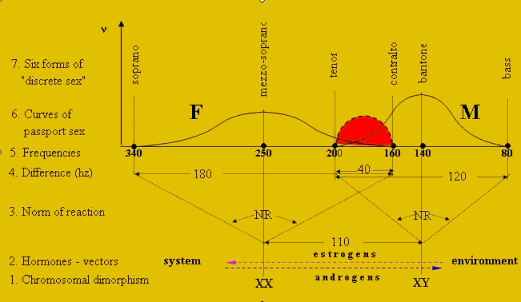|
The Evolutionary Theory of
Sex:
Hormonal Sex
“The sexes were not two as they are now, but originally
three in number;
there was man, woman, and the union of the
two, having a name
corresponding to this double nature,
which had once a real existence,
but is now lost, and the
word "Androgynous"…”
Plato “Symposium”
“… there are many gradations
running from female to male; and … one can argue that along
that spectrum lie at least five sexes and perhaps even
more.”
A. Fausto-Sterling “The Five Sexes”
“… since the beginning of humankind, a man's voice could
have
functioned as a testosterone advertisement.”
Sex is an alternative character
that distinguishes male and female individuals from each
other, allows them to produce different gametes and
participate in sexual reproduction. We will consider female
an individual that produces large usually immobile
gametes (as eggs). Accordingly male is an individual
that produces small usually mobile gametes (as
spermatozoids). Sex of an individual, as any other
character, is defined by a genotype and environment.
According to chromosomal theory, sex
chromosomes determine the sex at the moment of
fertilization. Without
Y-chromosome “asexual” rudiment of a gonad turns into
ovaries producing estrogen. Y-chromosome transforms gonad
into testes producing androgen.
Sex chromosomes define sex of a zygote
only at the level of genes, its homo- or hetero-gamety (XX
or XY). Further realization of sex in Ontogeny, i.e.
phenotypic sex, is influenced by sex hormones. While
chromosomal sex is discrete (intersexual dimorphism),
hormonal sex is continuous (inter- and intrasexual
polymorphism).

Sex hormones along with the other
features change the harmonics of the voice that occur during
male and female puberty. In the female, the impact of
estrogens produces the characteristics of the female voice,
with a fundamental frequency one third lower than that of a
child. In the male, androgens released at puberty are
responsible for the male vocal frequency, an octave lower
than that of a child.
Testosterone, the hormone that
elongates the vocal cords
during puberty, is also responsible for other manly
features - such as broad
shoulders and hairy faces. And as indicators of
sexual maturity, these traits may play a large role in the
process of finding a mate for reproduction. This means that
since the beginning of humankind, a man's voice could have
functioned as a testosterone advertisement.
To consider the differences caused by
sex hormones we shall allocate for simplicity inside of
man's and a female on three gradation of "a fractional sex":
modal, feminine, and masculine. Since sex hormones define
the tone (height) of voice in humans, these forms can be
presented as average frequencies of voices (in hertz). For
women it is a soprano (340 hz), mezzo-soprano (250 hz) and
contralto (160 hz). For men — a tenor (200 hz), baritone
(140 hz) and bass (80 hz).
Hormonal Sex and
Homosexuality ► Evolutionary role of
cancer ►
References:
A. Fausto-Sterling The Five Sexes: Why Male
and Female Are Not Enough The Sciences March/April 1993, p.
20-24. < http://www.mtsu.edu/~phollowa/5sexes.html
>
|